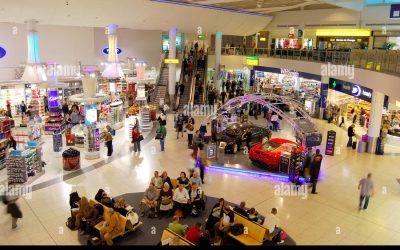CliqJets Consulting
Fostering Growth, Innovation, and Sustainability in Airline Operations

The Intersection of Branding and Culture: Transforming Passenger Perception in the Airline Industry
According to an article (Yohn, 2019) at Harvard Business School, “If you want to produce the kinds of specific outcomes that will allow your company to differentiate from others, you need to define a unique culture that cultivates the necessary kinds of employee attitudes and behaviors. “In the fiercely competitive landscape of the airline industry, branding and culture are not merely buzzwords but crucial determinants of success. Airlines worldwide grapple with the challenge of crafting a distinct identity while fostering a culture that resonates with passengers. In this article, we delve into how branding and culture profoundly influence passenger perception and provide recommendations on enhancing these aspects to elevate the customer experience.
What is branding and culture?
A brand is a product or a business that has a distinct identity in the perception of consumers Yohn (2019).
What is culture?
Culture is how organizations ‘do things’ according to Robbie Katanga as cited in Harvard Business Review Yohn (2019).
Generally, branding and company culture play a pivotal role in shaping passengers’ perceptions and experiences. Beyond merely providing a means of transportation, airlines are in the business of delivering a promise—a promise of safety, comfort, and reliability. How effectively this promise is communicated and fulfilled can significantly impact passenger satisfaction, loyalty, and ultimately, the success of an airline.
The Significance of Branding and Culture:
Branding goes far beyond logos and slogans; it encapsulates the essence of what an airline stands for. A strong brand communicates trust, reliability, and a unique value proposition that resonates with passengers. It creates an emotional connection that extends beyond the physical aspects of air travel. Culture, on the other hand, reflects the internal values, norms, and behaviors within an airline organization. A positive company culture translates into motivated employees who are committed to delivering exceptional service, further reinforcing the brand image.
Flight Dispatchers: Handling Uncertainty in Turbulent Times
- When Safety Meets the Clock: Why Airlines Can’t Afford to Gamble
- NSIB Hosts 12th BAGAIA Commission Meeting in Abuja
- ✈️ How Commercial Airlines Boost Nigeria’s GDP
Passengers often choose airlines based on their perception of the brand. Whether it’s the aura of luxury associated with premium carriers or the affordability and accessibility offered by budget airlines, branding plays a pivotal role in decision-making. For instance, airlines like Emirates have meticulously cultivated an image of opulence and world-class service, attracting discerning travelers seeking a premium experience.
Additionally, passengers can discern the culture of an airline through various touchpoints, such as interactions with staff, onboard amenities, and overall ambiance. Airlines with a culture of excellence prioritize continuous improvement and innovation, striving to exceed passenger expectations at every turn. Conversely, airlines plagued by negative cultures often struggle with inconsistent service and employee disengagement, leading to dissatisfied passengers.
Impact on Passenger Perception
The amalgamation of branding and culture significantly shapes passenger perception, influencing their overall experience and likelihood of repeat business. A cohesive brand backed by a strong organizational culture fosters trust and confidence among passengers, encouraging loyalty and advocacy. Conversely, inconsistencies between brand promises and actual experiences can erode trust and tarnish the airline’s reputation.
Passengers are increasingly discerning, seeking airlines that align with their values and preferences. They crave authenticity and meaningful connections, making it imperative for airlines to convey a genuine brand identity and foster a culture that resonates with passengers. A positive passenger perception not only drives revenue but also enhances the airline’s competitive edge in a crowded marketplace.
Recommendations for Improvement
- Define a Compelling Brand Identity: Clearly articulate the brand’s values, positioning, and unique selling propositions to differentiate it from competitors.
- Cultivate a Positive Company Culture: Invest in employee training, empowerment, and recognition programs to foster a culture of excellence, teamwork, and accountability.
- Align Brand Promises with Passenger Experience: Ensure consistency across all touchpoints, from reservation to post-flight interactions, to deliver on brand promises and exceed passenger expectations.
- Embrace Innovation and Adaptability: Stay attuned to evolving passenger preferences and industry trends, leveraging technology and creativity to enhance the passenger experience.
- Solicit and Act on Passenger Feedback: Regularly solicit feedback from passengers and employees to identify areas for improvement and implement actionable solutions.
- Engage in Purposeful Marketing and Communication: Communicate the brand’s story, values, and commitment to passenger satisfaction through marketing campaigns and social media engagement.
Finally, branding and culture are integral facets of the airline industry, wielding immense influence over passenger perception and loyalty. By aligning brand identity with organizational culture and prioritizing the passenger experience, airlines can cultivate a positive reputation, drive customer loyalty, and thrive in an increasingly competitive market.
References
Kenton, W. (2022, March 24). Brand: Types of Brands and How to Create a Successful Brand Identity. Investopedia. https://www.investopedia.com/terms/b/brand.asp
Yohn, D. L. (2019, December 17). Build a Culture to Match Your Brand. Harvard Business Review. https://hbr.org/2019/12/build-a-culture-to-match-your-brand





0 Comments